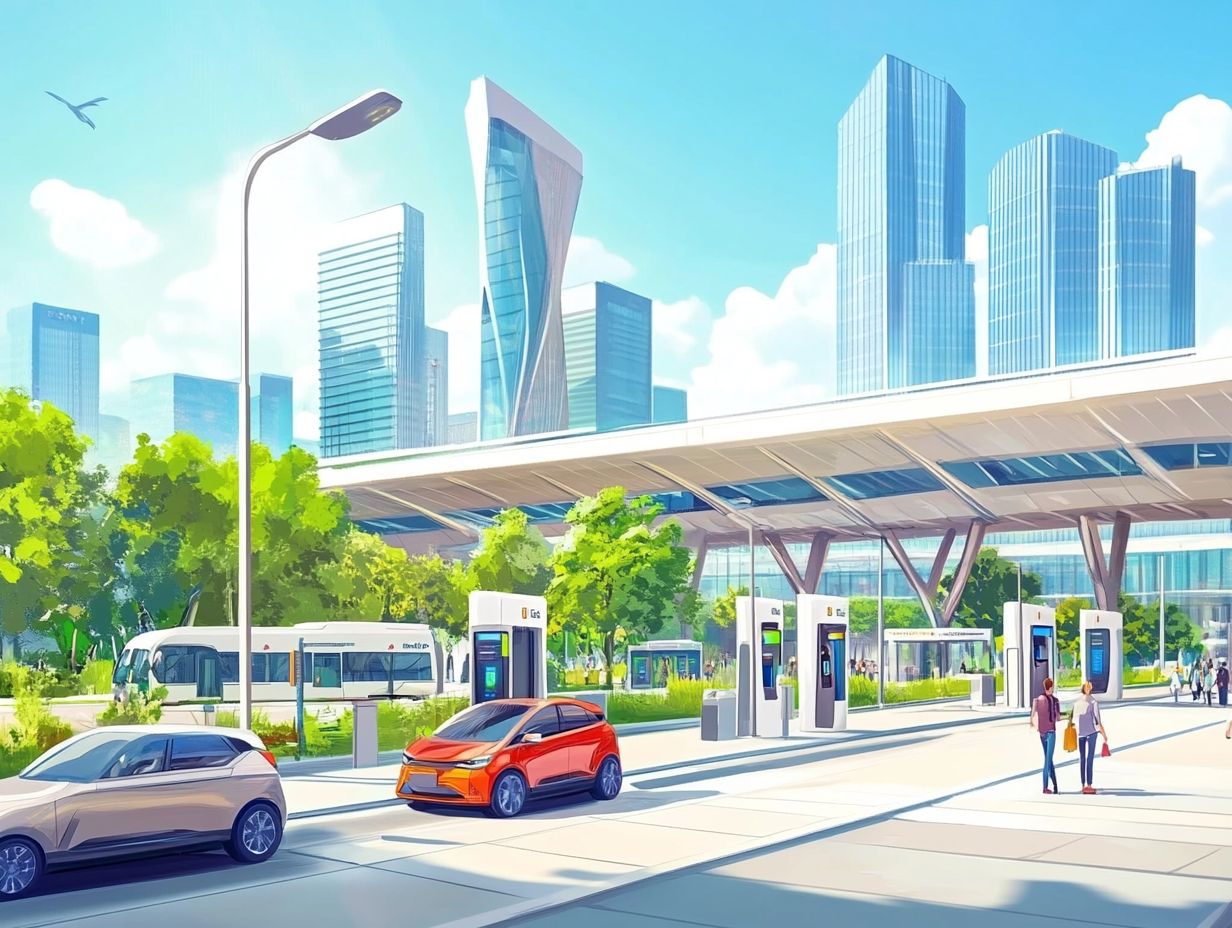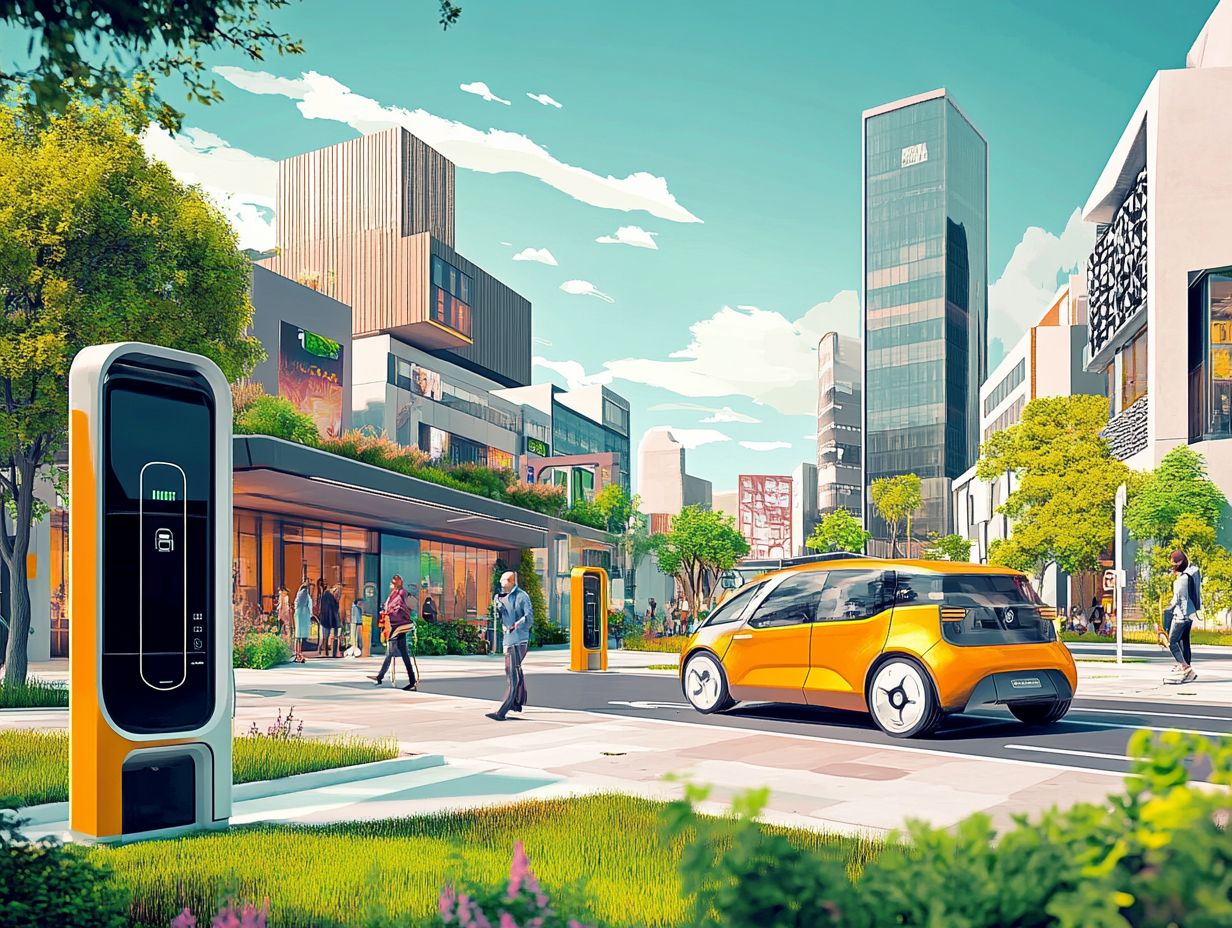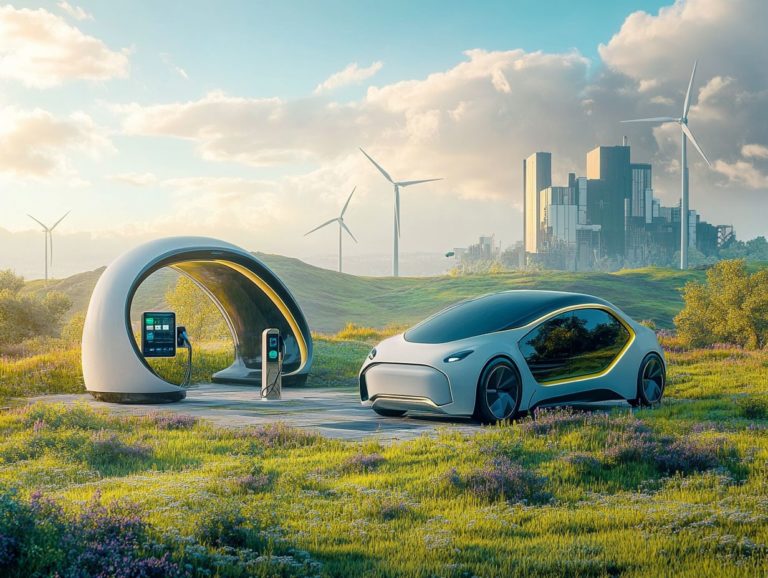5 Ways Cities are Adapting to EV Growth
As urban areas strive to combat climate change and enhance air quality, you ll notice the momentum behind electric vehicles (EVs) picking up speed. Cities are rising to the occasion by expanding EV infrastructure, rolling out enticing incentives for drivers, and enhancing public transportation options.
Discover five powerful strategies cities are using right now to boost electric vehicle adoption!
This article delves into key strategies that cities are employing to foster the growth of EVs. From increasing the number of charging stations to forming strategic partnerships with private companies, explore how urban centers are paving the way for a sustainable future and what it truly means for residents and businesses alike.
Contents
- 1. Increasing Number of EV Charging Stations
- 2. Incentives and Subsidies for EV Owners
- 3. Implementation of Clean Air Zones
- 5. Collaboration with Private Companies for EV Infrastructure
- What Is Driving the Growth of EVs in Cities?
- Frequently Asked Questions
- What are the top 5 ways cities are adapting to EV growth?
- How are cities expanding charging infrastructure for EVs?
- What exciting incentives are cities providing to encourage electric vehicle adoption?
- How is the use of electric vehicle fleets benefiting cities?
- What are cities doing to create dedicated EV parking spaces?
- How are cities incorporating EV-friendly policies in urban planning?
Key Takeaways:

- An increasing number of EV charging stations are being implemented in cities to meet the growing demand for EVs, making it easier for EV owners to find charging options.
- Cities are offering incentives and subsidies for EV owners, making it more affordable for individuals to switch to electric vehicles.
- Clean air zones are being established in cities to combat air pollution and encourage the use of electric transportation.
1. Increasing Number of EV Charging Stations
Charging stations are the backbone of electric vehicle adoption, and here s why: The growing number of EV charging stations plays a crucial role in boosting electric vehicle (EV) adoption. By directly addressing concerns about charging infrastructure and convenience, it lays the groundwork for a more sustainable transportation future worldwide, especially in pioneering markets like Norway and China.
Recent statistics show that the U.S. alone boasts over 100,000 public charging points, and this number is set to soar thanks to substantial governmental incentives aimed at encouraging such developments. With public and private sectors joining forces to invest in charging infrastructure, urban areas are experiencing a rise in accessible charging options. This makes it simpler for city dwellers to make the switch to electric vehicles.
This expansion not only supports the EV market but also plays a significant role in reducing harmful gases that contribute to climate change. It fosters cleaner air and a healthier environment. The growth of charging stations supports the shift toward sustainable practices in transportation.
2. Incentives and Subsidies for EV Owners
Financial incentives and subsidies for EV owners are key in stimulating the electric vehicle market’s growth, especially for low-income households. This approach drives higher adoption rates and supports the objectives of climate action trackers.
These incentives come in various forms, including tax breaks that reduce the overall purchase cost and rebates that offer immediate financial relief. Production subsidies urge manufacturers to create more affordable electric models.
In the United States, policies like the federal tax credit for electric vehicle purchases have effectively boosted sales. States like California have stepped up with additional rebates to further entice buyers.
Similarly, the European Union has rolled out an impressive array of incentives, including substantial subsidies and low-emission zone policies. These measures not only promote immediate sales but also pave the way for long-term sustainability and innovation in the automotive industry.
3. Implementation of Clean Air Zones
The implementation of clean air zones is a forward-thinking strategy to reduce greenhouse gas emissions in urban areas. By encouraging the shift to zero-emission vehicles, these zones promote environmental justice and enhance air quality for all communities.
In cities like London and Paris, clean air zones restrict access for high-emission vehicles. This incentivizes residents and business owners to consider electric alternatives. This shift improves urban air quality and creates a healthier environment for everyone, particularly benefiting vulnerable populations most affected by pollution.
As a result, you may notice a significant reduction in health issues tied to poor air quality, such as respiratory diseases. Additionally, businesses have fresh opportunities for green initiatives, driving local economies forward while contributing to a sustainable future.
Ultimately, clean air zones foster a shared responsibility among citizens and organizations to prioritize emissions reductions and embrace clean transportation.
5. Collaboration with Private Companies for EV Infrastructure

Collaboration with private companies is essential to developing robust EV infrastructure. By ensuring that electric vehicles are supported by adequate charging stations and services, you can significantly enhance the growth potential of the electric vehicle industry.
This synergy accelerates the rollout of charging stations and cultivates a more competitive marketplace for electric vehicles. By pooling resources, you and local governments can share the financial burden, creating an environment where innovation thrives.
Many cities have successfully partnered with charging network providers, leading to a notable increase in available charging points. These collaborations often extend to workforce development initiatives, equipping individuals with essential skills for electric vehicle manufacturing and highlighting how EVs contribute to a circular economy.
Programs like these show how effective partnerships can lead to technological advancements, drive job creation, and ultimately contribute to a greener future.
What Is Driving the Growth of EVs in Cities?
The rise of electric vehicles (EVs) in urban environments is fueled by a unique blend of factors. You ll find that increased government support, consumer choice, and growing awareness of the environmental benefits tied to EV adoption all play a significant role, as highlighted by organizations like the International Energy Agency and frontrunners like Norway and China.
Advancements in battery technology have dramatically reduced costs and enhanced performance, making EVs more accessible for you, the average consumer. Financial incentives, such as tax credits and rebates, further ease your transition from traditional gasoline-powered vehicles.
Equally vital is the shift in consumer mindset. More and more, you prioritize sustainability and energy efficiency in your purchasing decisions. Combined with supportive government policies aimed at bolstering renewable energy infrastructure and reducing emissions, these factors create a powerful framework that nurtures the growth of electric vehicles. As a result, they are becoming a familiar sight on the roads of your cities.
How Can Cities Overcome Challenges in Adopting EVs?
Cities encounter many challenges when adopting electric vehicles, such as insufficient charging infrastructure, high initial costs, and the pressing need for consumer education about the benefits of EVs. However, these obstacles can be addressed by understanding 5 ways EVs support sustainable development goals through thoughtful planning and collaboration.
One prominent barrier is the limited availability of charging stations, which may dissuade potential EV owners uncertain about where they can recharge their vehicles. The upfront costs of electric vehicles can seem daunting, especially for those who may not yet realize the long-term savings from reduced fuel and maintenance expenses. Public perception is another crucial factor, as misinformation can understandably breed hesitancy.
Cities should prioritize substantial investments in charging infrastructure to ensure that stations are plentiful and easily accessible. Additionally, they should explore how EVs are contributing to smart cities by implementing targeted financial incentives to lower entry costs for consumers, making the transition to electric vehicles not just appealing but entirely feasible.
What Are the Benefits of EVs for Cities?
The benefits of electric vehicles in urban settings are remarkable. By embracing EVs, cities can expect significant reductions in greenhouse gas emissions, improved air quality, and enhanced sustainable transportation options, all contributing to fair treatment of communities regarding the environment.
Integrating electric vehicles into city infrastructure not only elevates environmental standards but also boosts economic efficiency. Cities will see reduced fuel and maintenance costs, alongside the creation of jobs in the burgeoning green technology sector. This adoption aligns seamlessly with sustainable public transportation initiatives, making mass transit systems more appealing and accessible to residents. As a result, public engagement and participation naturally increase.
As neighborhoods enjoy the perks of cleaner air and quieter streets, the community thrives with healthier lifestyles and lively interactions. This transformation enhances the sense of belonging among residents, turning urban living into something exceptional.
How Can Cities Ensure Equal Access to EVs for All Communities?

Ensuring equal access to electric vehicles for all communities, particularly low-income households, is essential for realizing true environmental justice and maximizing the benefits of EV adoption across diverse populations.
Cities can implement strategies to achieve this goal. Consider targeted financial incentives, such as rebates or tax credits aimed at lower-income families, which can make EV ownership more feasible.
Investing in infrastructure development in underserved neighborhoods like placing charging stations in public areas will significantly improve accessibility.
Engaging the community through educational initiatives and outreach programs is equally important. These efforts raise awareness about the benefits of EVs and available resources. Successful case studies from places like California and Washington D.C. show the effectiveness of these approaches in creating a more equitable EV landscape.
This highlights the urgent need for robust policy recommendations to ensure ongoing progress and inclusivity in the transition to electric vehicles.
Let s advocate for EV initiatives in our cities to create a cleaner, greener future for everyone!
What Are the Future Possibilities for EVs in Cities?
The future possibilities for electric vehicles in urban areas are indeed promising. Advancements in electric mobility technologies and renewable energy sources are paving the way for more integrated and sustainable transportation systems.
As you observe the rise of smart city initiatives, you’ll notice that municipalities are increasingly focusing on innovative charging solutions powered by solar and wind energy. This shift not only bolsters the EV infrastructure but also fosters a wider acceptance of electric vehicles among residents, highlighting the future of electric vehicles in sustainable cities.
With manufacturers ramping up their investment in research and development, significant improvements in the design and efficiency of EVs are expected. This will lead to reduced costs and enhanced performance.
The synergy between renewable energy and electric vehicle adoption has the potential to redefine urban mobility, resulting in cleaner air and quieter streets. This creates a compelling case for cities to fully embrace this technological evolution!
Boosting Business with Electric Vehicles: How Cities Can Help!
Cities have the opportunity to promote electric vehicle (EV) usage among businesses through financial incentives, the establishment of conveniently located EV charging stations, and comprehensive electric vehicle policies that ease the transition to electric mobility. For more insights, check out how to prepare for the EV boom in your city.
These initiatives enable businesses to lower their operational costs over time and elevate their public image as environmentally conscious organizations dedicated to sustainability. Offering tax incentives for companies that adopt electric fleets significantly reduces the upfront costs tied to this transition.
Collaborating with private companies and local governments to build an extensive network of charging stations ensures that both employees and customers have effortless access to charging facilities. This approach simplifies logistics for businesses while aiding in reducing greenhouse gas emissions and enhancing air quality in the community, ultimately fostering a healthier environment for everyone!
Frequently Asked Questions
What are the top 5 ways cities are adapting to EV growth?

Cities are implementing a variety of strategies to accommodate the increasing use of electric vehicles. These include expanding charging infrastructure, promoting electric vehicle incentives, implementing electric vehicle fleets, creating dedicated EV parking spaces, and incorporating EV-friendly policies in urban planning.
How are cities expanding charging infrastructure for EVs?
Cities are installing more public charging stations in high-traffic areas such as shopping centers, parking garages, and office buildings. They are also partnering with private companies to install charging stations in public spaces and offering incentives for private residences to install home charging stations.
What exciting incentives are cities providing to encourage electric vehicle adoption?
Cities are offering a variety of incentives to encourage people to switch to EVs, such as tax rebates, discounted parking fees, and free charging. Additionally, some cities are exploring how EVs are shaping urban mobility by implementing electric vehicle purchase mandates, requiring a certain percentage of new vehicles sold to be electric.
How is the use of electric vehicle fleets benefiting cities?
Cities are incorporating electric vehicle fleets into their public transportation systems, reducing emissions and air pollution. This also serves as a model for individuals to see the benefits of driving an electric vehicle and encourages them to make the switch!
What are cities doing to create dedicated EV parking spaces?
Cities are designating specific parking spaces for electric vehicles, often with charging stations nearby. This ensures that EV drivers have access to convenient and reliable charging options.
How are cities incorporating EV-friendly policies in urban planning?
Cities are considering the needs of electric vehicle owners in their urban planning, such as incorporating charging infrastructure into new developments and creating designated EV lanes on roads. Implementing these strategies can promote sustainability in EV usage, helping to create a more EV-friendly environment and encouraging the use of electric vehicles in the city.
Act now and embrace electric vehicles to lead the way in sustainable urban transport!






